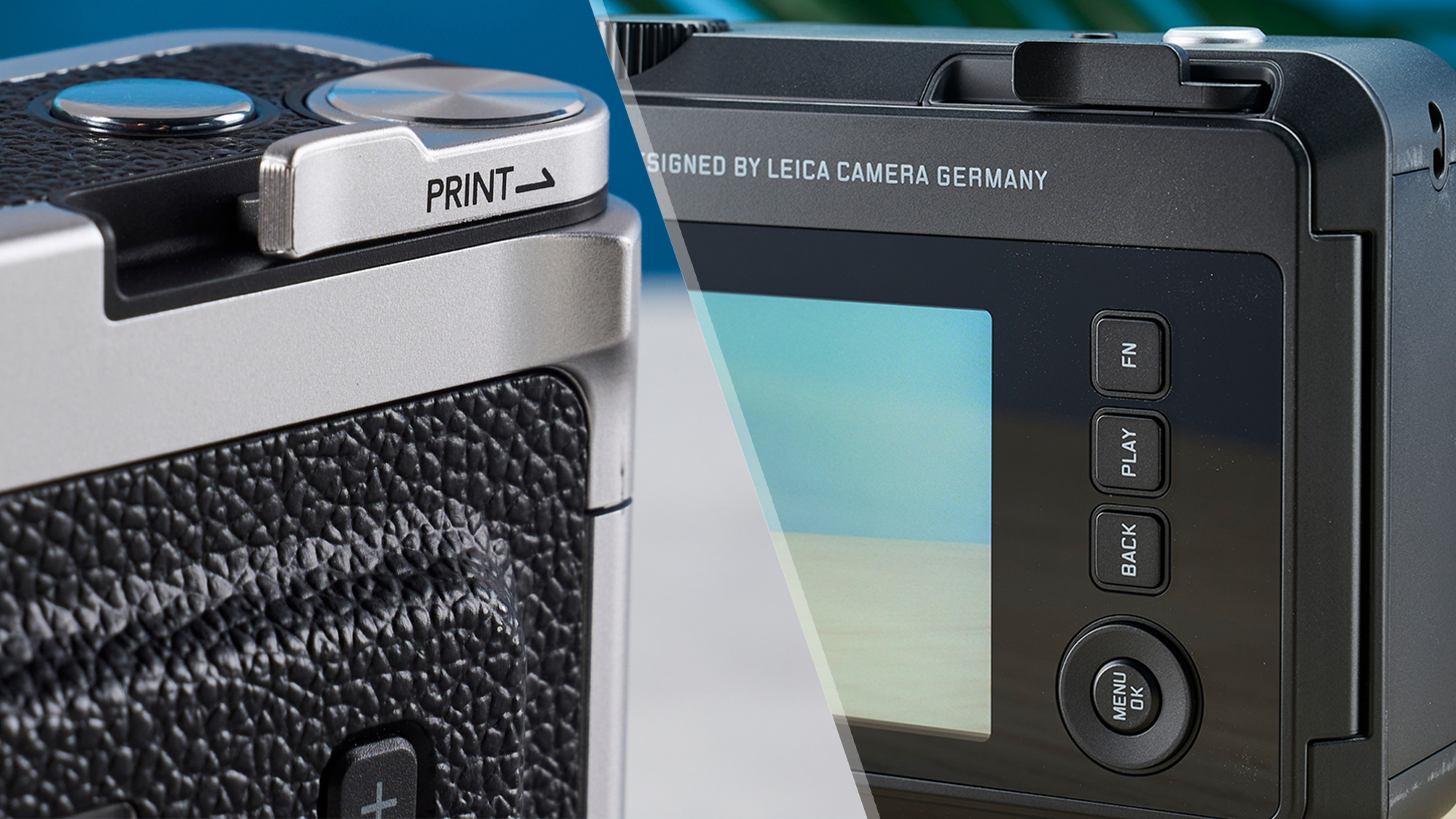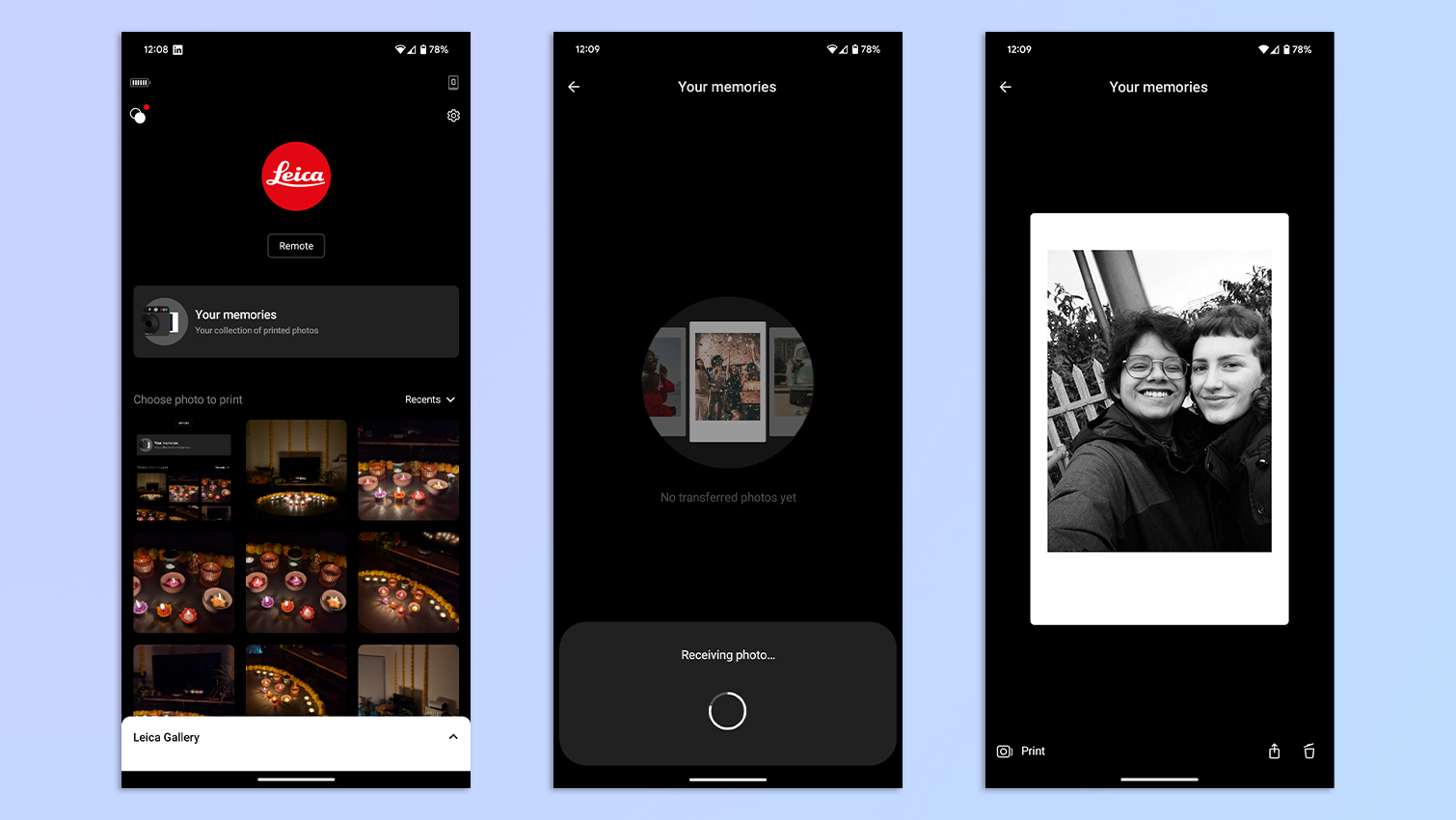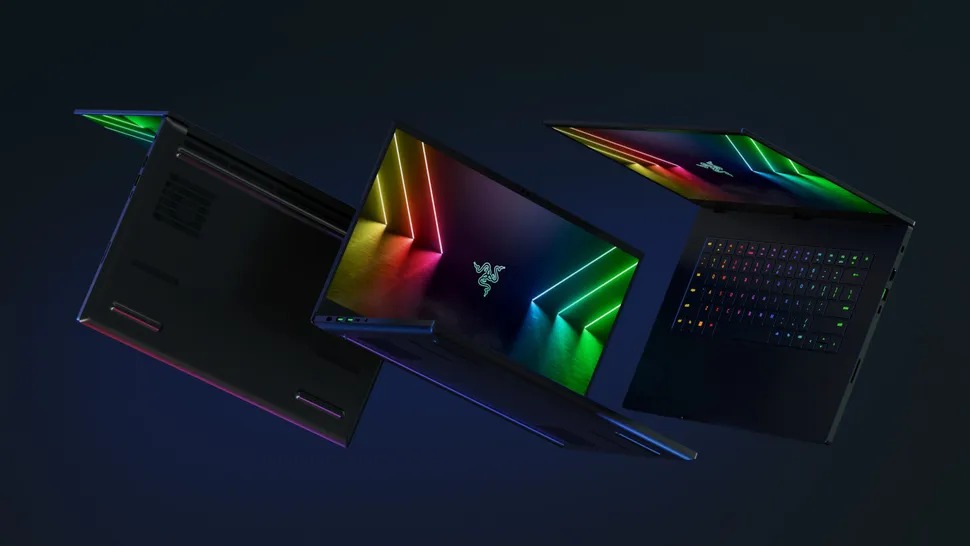Fujifilm Instax mini Evo vs. Leica Sofort 2: Which instant camera wins?
Is it worth spending double on the red-badged Leica?

The Fujifilm Instax mini Evo allows you to get truly creative with 100 different effect combinations, and the images it produces are gorgeous. The camera performs fantastically in low-light conditions too, and it’s compact and portable, making it ideal for travel. But not all photos can be transferred to your smartphone, and internal memory is limited.
For
- Premium, retro-looking body
- Compact and portable
- 100 different effect combinations
- Excellent image quality
- Great low-light performance
Against
- Limited photo transfer capabilities
- Limited internal memory

A Leica for less? The Sofort 2 is the German manufacturer’s only instant camera, and it sports a modern, minimalistic design and premium build quality. With 100 different creative looks, the camera takes great photos too. However, internal memory and photo transfer capabilities are limited, and it’s very expensive.
For
- Modern, minimalist design
- 100 different effect combinations
- Excellent image and print quality
- Compact and portable
- Great low-light performance
Against
- Expensive
- Limited internal memory
- Limited photo transfer capabilities
As a reviews writer at Tom's Guide, I've tested some of the best instant cameras — from Fujifilm and Polaroid to Kodak and Lomography. There are many different types of instant cameras. Some have viewfinders, while some have LCD screens. Some let you just take a photo and be done, while others let you get creative with different effects. The Fujifilm Instax mini Evo is my favorite, and the Leica Sofort 2 came very close to dethroning it.
Is there any difference between the two? Nearly $200 separate them after all. One's also the cheapest Leica money can buy right now. But is there a difference in the image quality, customization capabilities and design? Yes and no.
In this Fujifilm Instax mini Evo vs. Leica Sofort 2 face-off, I'll break down the key differences and similarities to determine the winner.
Fujifilm Instax mini Evo vs. Leica Sofort 2: Specs compared
| Specs | Fujifilm Instax mini Evo | Leica Sofort 2 |
|---|---|---|
| Price | $199 / £174 | $399 / £360 |
| Lens | Fixed-focus lens | Fixed-focus lens |
| Viewfinder | No | No |
| Exposure control | -2.0 EV to +2.0 EV, ISO 100-1600 | -2.0 EV to +2.0 EV, ISO 100-1600 |
| Shutter | 1/4 to 1/8000 seconds | 1/4 to 1/8000 seconds |
| Focal length | 28mm | 28mm |
| Aperture | f/2 | f/2-f/16 |
| Image sensor | 1/5-inch CMOS | 1/5-inch CMOS |
| Shooting range | 10cm-∞ | 10cm-∞ |
| Flash | Automatic | Automatic |
| Flash refresh time | Not specified | Not specified |
| Flash range | 50cm-1.5m | 50cm-1.5m |
| Self-timer | 2-10 seconds | 2-10 seconds |
| Internal storage | 45 photos | 45 photos |
| microSD slot | Yes | Yes |
| Power | Rechargeable Lithium-ion battery | Rechargeable Lithium-ion battery |
| Dimensions | 4.83 x 3.42 x 1.41 inches | 4.84 x 3.38 x 1.73 inches |
| Weight | 10.05 ounces | 11.28 ounces |
| Film used | Instax mini film | Instax mini film |
| Film development time | Up to 90 seconds | Up to 90 seconds |
| Cost per print | 75¢ | 75¢ |
Fujifilm Instax mini Evo vs. Leica Sofort 2: Price & availability

The biggest difference between the Fujifilm Instax mini Evo and the Leica Sofort 2 is the price. You can pick up the Instax mini Evo for $199 at Amazon U.S. / £174 at Amazon U.K., while the Sofort 2 is available for $399 at Leica U.S. / £360 at Leica U.K.
The two cameras come in different colors too. The Instax mini Evo comes in either black or brown, while the Sofort 2 comes in black, white or red.
I won't lie, spending nearly double on the Sofort 2 feels a little futile, considering it has the same specs as the Instax mini Evo. You're basically paying an extra $200 for the red Leica badge. The winner here is clear: the Instax mini Evo is more value for money.
Winner: Fujifilm Instax mini Evo
Fujifilm Instax mini Evo vs. Leica Sofort 2: Design & build quality

Both the Fujifilm Instax mini Evo and the Leica Sofort 2 sport contrasting designs. The Instax mini Evo borrows styling cues from old film cameras, while the Sofort 2 is the sophisticated photographer’s instant camera, oozing with minimalism and modernity. It looks expensive too, with the red Leica badge on the front adding a subtle pop of color — especially to the black model.
The one thing both cameras share is their premium build quality and compact body. The Instax mini Evo measures 4.83 x 3.42 x 1.41 inches and the Sofort 2 is slightly bigger, at 4.84 x 3.38 x 1.73. Both cameras weigh just under 11.5 ounces too, which makes them comfortable to carry around a neck, hold in one hand, and even slip into a pocket. The Sofort 2 also comes with a magnetic lens cap while the Instax mini Evo doesn't.
It really depends on which type of style you prefer. I'm biased towards the vintage aesthetic but I can't deny how good the Sofort 2 looks either.
Winner: Tie
Fujifilm Instax mini Evo vs. Leica Sofort 2: Lens & viewfinder

Both the Fujifilm Instax mini Evo and the Leica Sofort 2 boast similar shooting capabilities. They're both fitted with 28mm fixed-focus lenses, so the focal lengths can't be adjusted — all you need to do is point and shoot. The only difference between the two is that the Instax mini Evo has an f/2 fixed aperture, while the Sofort 2 has a variable aperture of f/2 to f/16 which the camera automatically adjusts. Both cameras, therefore, perform well in low-light conditions. The Sofort 2 will be better suited to group photos, though.
Neither camera has a viewfinder, and that's because each is fitted with a 3-inch TFT color LCD screen. You won't miss having a viewfinder as the screen is big enough for you to properly frame your shots. The screen is very responsive on both cameras.
One important thing to note about both cameras' capabilities is the fact that their internal memories are limited to 45 photos. This can be extended by using a microSD card, though.
The Sofort 2 wins by a very narrow margin, and that's only because it's got a variable aperture.
Winner: Leica Sofort 2
Fujifilm Instax mini Evo vs. Leica Sofort 2: Controls

Controls are very similar too. The shutter button is located above each camera's lens, and the power button is located next to the lens. Around the lens is a dial which, when turned, lets you choose from 10 different effects — like fisheye, double exposure, etc. The top plates house an Effect Reset button, another shutter button, and the film dial which lets you choose from 10 different filters. Combine that with the 10 lens effects and you get 100 creative combinations on each camera.
The top plates also house the print lever which resembles the winding lever on old film cameras. Using the lever to print a photo feels much more satisfying than pressing a button. Most space on the back of each camera is taken up by the respective LCD screens, next to which you'll find the navigation controls.
The only (minuscule) difference between the Instax mini Evo's and Sofort 2's controls is that the Sofort 2's film dial doubles as a zoom dial, which lets you zoom into photos you've taken.
Winner: Tie
Fujifilm Instax mini Evo vs. Leica Sofort 2: Image & print quality


When it comes to the Fujifilm Instax mini Evo's and Leica Sofort 2's image quality, it's a close call. Both cameras are excellent, and the Instax mini Evo is so good that I used it to document my vacation a few months ago. Rain or shine, both cameras perform exceptionally well, as you can see in the sample photos above. The 100 effect combinations give you many opportunities to get creative too. I've had the most fun taking double exposures. The LCD screen is very helpful as, after you’ve taken the first exposure, it shows you how the second will line up.


Low-light performance is great too. In my Instax mini Evo review, I said it was "the best I’ve seen from an instant camera." And the Sofort 2 matches it, as you can see above. Both cameras have built-in flashes with a range of 50cm-1.5m, and I recommend leaving the flash on even when there's a light source in the vicinity. All images I took as part of the review process turned out sharp and detailed.
Winner: Tie
Fujifilm Instax mini Evo vs. Leica Sofort 2: App


The Fujifilm Instax mini Evo is compatible with its own dedicated app of the same name, while the Leica Sofort 2 is compatible with Leica FOTOS. Both apps are available on iOS and Android devices, are very easy to use, and look clean. You can use either to update either camera's firmware, remotely trigger the shutter, and transfer printed images to your phone.
Neither app wins here as both the Instax mini Evo and the Sofort 2 share a flaw. You can only transfer the images you've printed to your smartphone. The Sofort 2 would have won here if this problem didn't persist, especially considering that the camera costs nearly double.
Winner: Tie
Fujifilm Instax mini Evo vs. Leica Sofort 2: Film cost & yield

Both the Fujifilm Instax mini Evo and the Leica Sofort 2 use Instax mini film — either black and white or color. A double film pack (20 pieces of film) costs $14 / £14, so each print costs 75¢.
Instax mini film is cheaper than Polaroid Go film (used by the Polaroid Go Gen 2), which costs $19 / £18 for 16 pieces of film. However, it's more expensive than the paper used by the Kodak Mini Shot 2 Retro, 30 sheets of which cost $22 / £18 — nearly as much as Instax mini film, but slightly better value if film costs are a concern.
Winner: Tie
Fujifilm Instax mini Evo vs. Leica Sofort 2: Battery life

The similarities still haven't ended. The Fujifilm Instax mini Evo and the Leica Sofort 2 share the same battery life too. Both are equipped with rechargeable Lithium-ion batteries and USB-C ports, and it takes just under two hours for both to go from zero to 100%. Fujifilm and Leica claim that their cameras can last for 100 shots depending on usage conditions.
Both these cameras have far superior battery life compared to the Polaroid Go Gen 2 (18 shots), the Kodak Mini Shot 2 Retro (20 shots) and the Kodak Mini Shot 4 Era (25 shots).
Winner: Tie
Fujifilm Instax mini Evo vs. Leica Sofort 2: Verdict
| Header Cell - Column 0 | Fujifilm Instax mini Evo | Leica Sofort 2 |
|---|---|---|
| Price and value (5) | 5 | 1 |
| Design & build (15) | 15 | 15 |
| Controls & lens (10) | 8 | 10 |
| Image quality (25) | 25 | 25 |
| Creative options (20) | 20 | 20 |
| Film cost & yield (10) | 8 | 8 |
| App (5) | 3 | 3 |
| Battery life (10) | 10 | 10 |
| Total score (100) | 93 | 91 |
Ultimately, the Fujifilm Instax mini Evo wins by a hair. Its lower price plays a big part in this. While the Leica Sofort 2 is excellent in its own right, the fact that it costs nearly twice holds it back from being the best. Both cameras capture lovely images in bright and moderately lit conditions, and they're built like tanks. They also lack in the same areas, with both cameras' internal storage being limited to 45 photos only, and the inability to transfer all images to your smartphone.
The Instax mini Evo has, therefore, very rightfully earned the top spot on our best instant cameras buying guide. It's the one camera I've bought with my own money this year.
Sign up to get the BEST of Tom's Guide direct to your inbox.
Get instant access to breaking news, the hottest reviews, great deals and helpful tips.

Nikita is a Staff Writer on the Reviews team at Tom's Guide. She's a lifelong gaming and photography enthusiast, always on the lookout for the latest tech. Having worked as a Sub Editor and Writer for Canon EMEA, she has interviewed photographers from all over the world and working in different genres. When she’s not working, Nikita can usually be found sinking hours into RPGs on her PS5, flying a drone (she's a licensed drone pilot), at a concert, or watching F1. Her work has appeared in several publications including Motor Sport Magazine, NME, Marriott Bonvoy, The Independent, and Metro.
